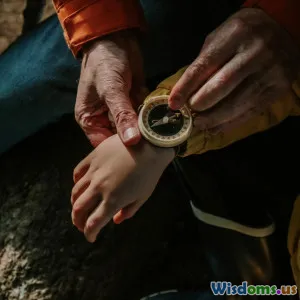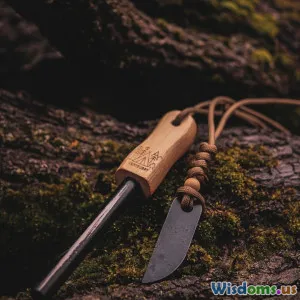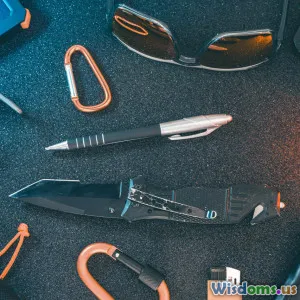
Could You Navigate Without a Compass? A Step by Step Approach
8 min read Master navigation without a compass using natural cues and simple techniques to stay oriented anywhere, anytime. (0 Reviews)
Could You Navigate Without a Compass? A Step by Step Approach
Imagine waking up in the middle of an unfamiliar forest: your compass is missing, batteries dead, or maybe you just prefer the old-fashioned way. Would you be able to find your way back safely? Navigating without a compass isn’t just a forgotten skill but an empowering survival technique that every traveler and adventurer should master.
In this article, we’ll explore how to confidently navigate without a compass, leveraging natural cues, observation skills, and practical methods rooted both in history and science.
Why Learn to Navigate Without a Compass?
Relying exclusively on modern gadgets creates vulnerability in survival situations. Here are a few reasons why non-compass navigation skills remain crucial:
- Electronic Failure: Batteries die, GPS signals get lost.
- Lost Equipment: Compasses or maps can be misplaced.
- Wilderness Confidence: Knowing how to orient yourself builds mental resilience.
- Cultural Heritage: Humans have thrived through natural navigation for millennia.
Famed explorer Ernest Shackleton once said, “Fortune favors the prepared mind.” Knowing how to use nature’s own navigation system could literally save your life.
Step 1: Understanding Basic Directions Without a Compass
Using the Sun
The sun is the most reliable directional tool during daylight:
- Sunrise and Sunset: The sun rises roughly in the east and sets in the west. If you observe the sun rising, facing it means you’re looking east; hence, west is directly behind you.
- Tracking Time: At noon, the sun sits roughly toward true south in the Northern Hemisphere and north in the Southern Hemisphere.
Example: David Halstead, an experienced mountaineer, once got lost while trekking the Rockies and used the sun’s position at noon to adjust his route east when GPS failed.
Using Shadows
-
Shadow Stick Method: Place a stick vertically into the ground and mark the tip of its shadow with a small stone or marker. Wait 15–20 minutes and mark the new position of the shadow tip. Draw a straight line between the first and second marks; this line runs roughly west (first mark) to east (second mark).
-
Why it Works: Because shadows move westward as the sun progresses.
This simple method is surprisingly accurate for basic orientation.
Step 2: Navigating with Natural Landmarks
Humans are excellent at pattern recognition, and natural landmarks are essential tools:
- Recognize Permanent Landmarks: Mountains, rivers, large rock formations, and unusual tree shapes serve as natural guides.
- Course Correction: If you know your general destination lies toward a mountain range, keep it consistently in your field of vision to avoid straying.
Pro Tip: Keep a mental or physical map made from your surroundings to triangulate your position over time.
Using Vegetation and Terrain
Certain ecosystems give clues about direction—for example:
- Moss Growth: Moss tends to grow on the northern side of trees in the Northern Hemisphere due to less sunlight.
- Slope and Water Flow: Streams and rivers generally flow downhill; following them downstream often leads to larger bodies of water or human settlements.
However, such indicators vary by region and season, so always use them alongside other methods.
Step 3: Navigating at Night Using the Stars
Identify Key Stars
If you find yourself lost after dark, the sky becomes an orienting tool:
- Northern Hemisphere – Polaris (North Star): Locate the Big Dipper constellation, use the 'pointer' stars along the bucket’s edge extending outward to find Polaris, which almost directly marks true north.
- Southern Hemisphere – Southern Cross: Draw an imaginary line along the longer axis of the Southern Cross and extend it about four and a half times to approximate the south celestial pole.
Benefits
Celestial navigation is a timeless technique that sailors and explorers have used for centuries. Even a basic knowledge here can provide solid bearings.
Step 4: Read Your Environment to Mark Your Path
Footprints and Man-Made Trails
- Follow Animal Tracks: Animals often move toward water or open areas; following tracks can lead to trails or human habitation.
- Man-made Signs: In wilderness areas, hunters and hikers leave markings like stacked stones (cairns) or paint blazes on trees.
Maintain Awareness
Stay mindful of changes in the environment to avoid going in circles—a common mistake when disoriented.
Tip: Carry a small notebook or use smartphone notes (when signal is available) to jot landmarks or directional cues.
Step 5: Practice and Preparation
Being competent without a compass requires both knowledge and experience:
- Practice Makes Proficient: Regularly practice these navigation techniques in your local area.
- Simulation Drills: Try leaving your compass at home during short hikes to train your natural sense of direction.
- Educate Yourself with Maps: Understanding topographical maps also greatly improves your terrain intuition.
Survival expert Les Stroud highlights, “Trust your observation skills and instincts but confirm your direction with multiple methods before moving.”
Conclusion: Empower Yourself with Navigational Confidence
Navigating without a compass may seem daunting at first, but it unlocks a primal and empowering connection with nature. By honing skills such as sun and star navigation, interpreting natural signs, and employing simple tools like shadow sticks, you build a resilient survival toolkit.
Whether you’re an avid adventurer, a survival enthusiast, or someone who just wants to get back to basics, mastering these techniques can provide peace of mind and self-reliance. Remember, the wilderness operates on nature’s clock – learn to read its signs, and you’ll never be truly lost.
Start now. Venture out, practice, observe, and prepare. Your next adventure may thank you.
Rate the Post
User Reviews
Popular Posts



















